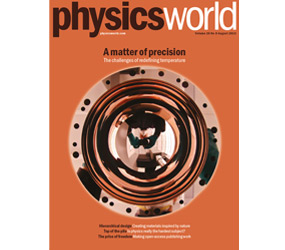In this month’s edition of Physics World, a group of physicists describe how unique structures in the natural world are inspiring scientists to develop new types of materials with unprecedented properties.
From adhesive tape inspired by the toes of geckoes to a potential flaw-resistant coating of aeroplanes inspired by mother of pearl, the attractiveness centres on one concept – hierarchical design.
When materials have a hierarchical design, the overall structure is made up of much smaller levels, or generations, of structures that when put together exhibit extraordinary properties.
For example, the ability of geckoes to walk up vertical walls and across ceilings is down to the hierarchical layout of small fibres on their toes. Each toe has a pad with hairy fibres protruding from it that repeatedly split into finer and finer hairs with dimensions down to the nanoscale.
This repeated splitting increases the surface area of the toes considerably and helps fix the gecko’s toe to a surface.
Before these natural structures were discovered, however, architects were using this hierarchical approach to design some of the most famous buildings and structures that are still standing today.
Perhaps the most famous example is the Eiffel Tower, which is predominantly made up of small beams that combine to form larger beams, which combine again to create even larger beams, and so on for a total of three structural generations.
The Eiffel Tower was built for the 1889 World’s Fair and the design plans of Gustav Eiffel meant that by the time it came to construction, materials were used sparingly. In fact, if you were to melt down the entire tower’s iron into a solid block with a base area equal to that of the tower, the block would only stand 6 cm above the ground.
More than 100 years later, scientists and engineers are now looking at the most efficient way of using this hierarchical approach to create exotic man-made materials called metamaterials.
In this article, Daniel Rayneau-Kirkope, from Aalto University, Yong Mao, from the University of Nottingham, and Robert Farr, from the London Institute of Mathematical Sciences, explain how these types of structures can be optimized by understanding the precise relationship between structure and function.
Technologies required to make these complex designs are progressing apace. Some researchers are trying to develop an industrial-scale process to construct materials that mimic nacre, also known as mother of pearl.
Nacre is an incredibly strong material that is produced by some molluscs as an inner shell; it also makes up the outer coating of pearls and has a fracture resistance 3000 times greater than crystals.
“By starting with materials that nature does not use for structural purposes, there is a chance that the advantageous properties of nacre and other examples of naturally occurring hierarchical design could even be surpassed by man-made composites,” the researchers write.
